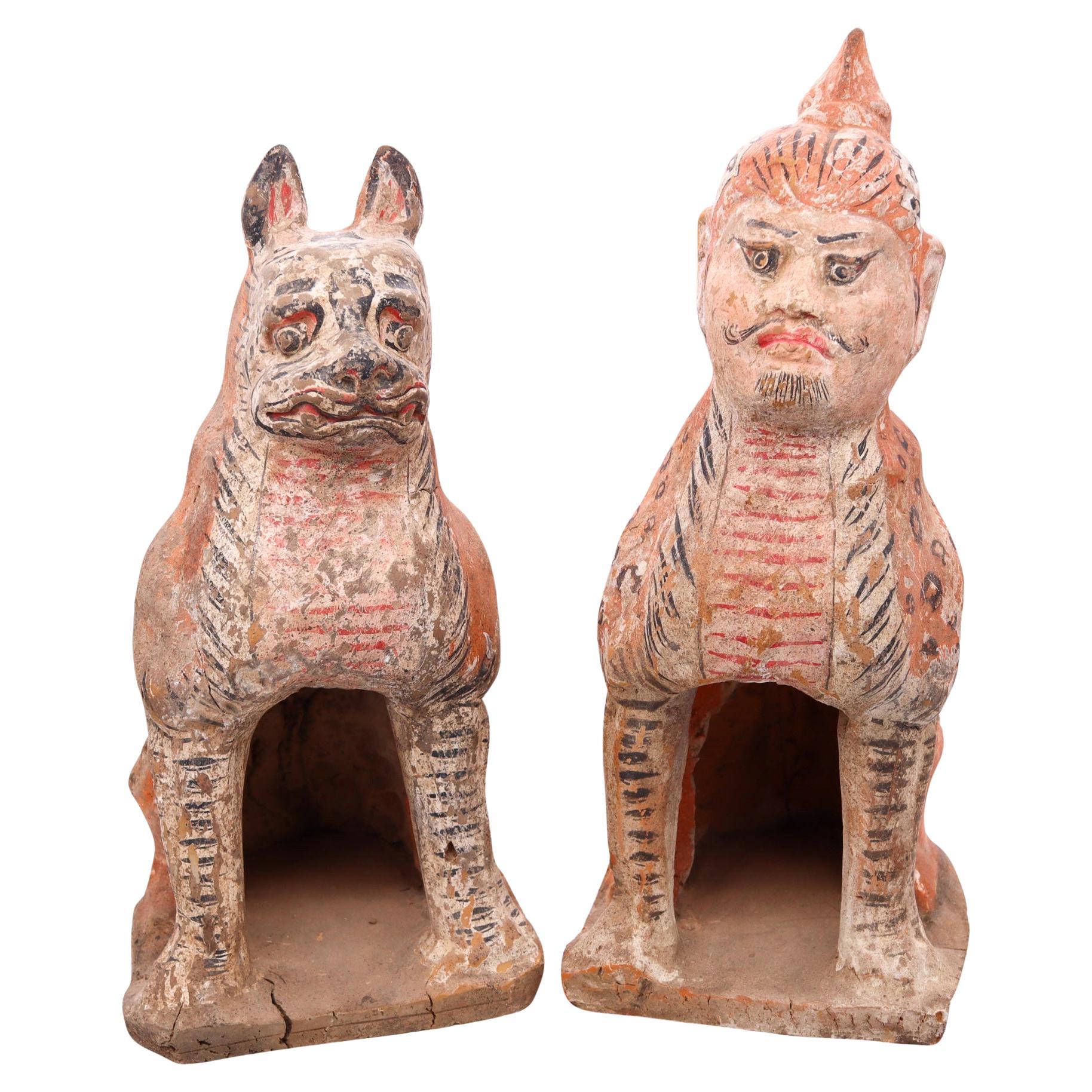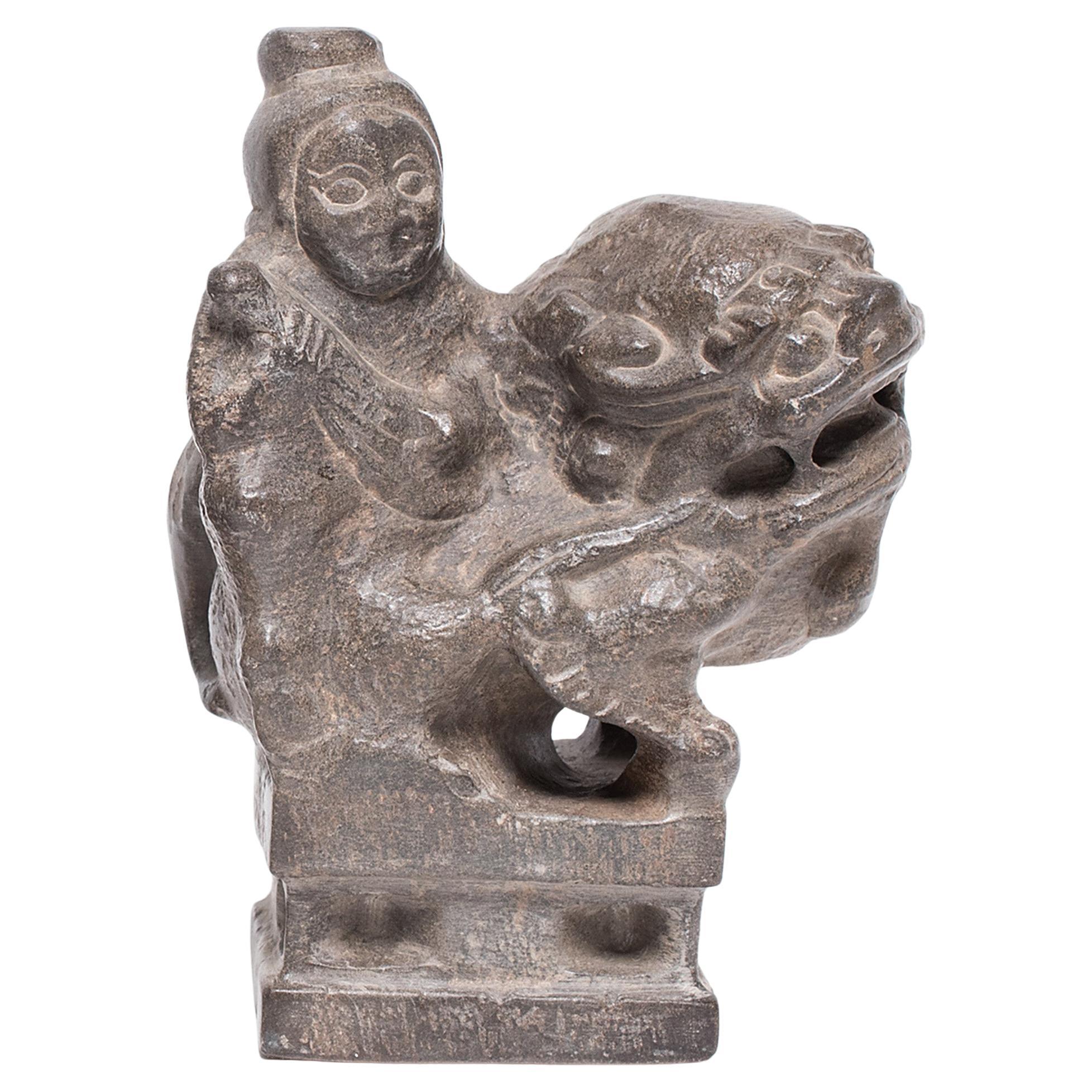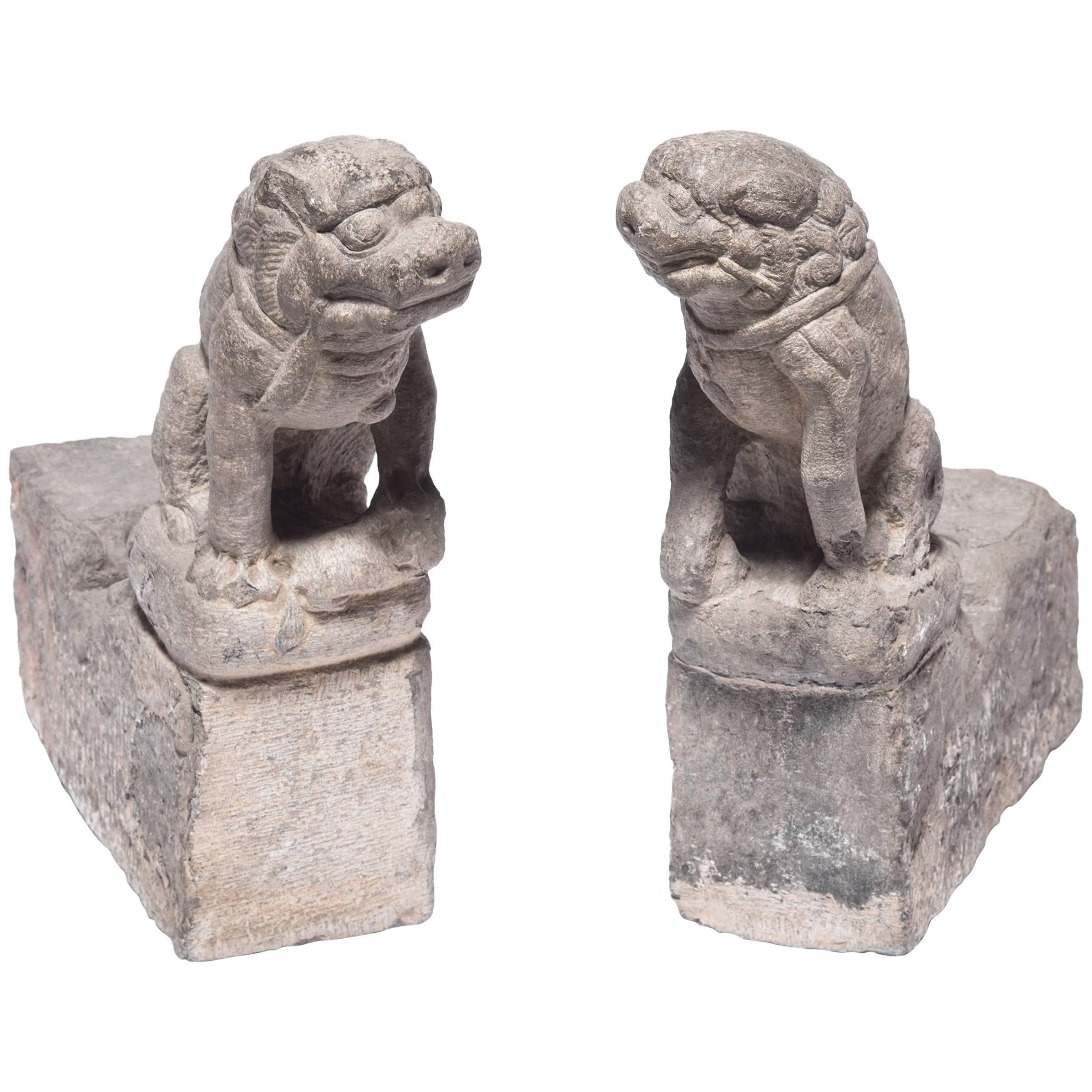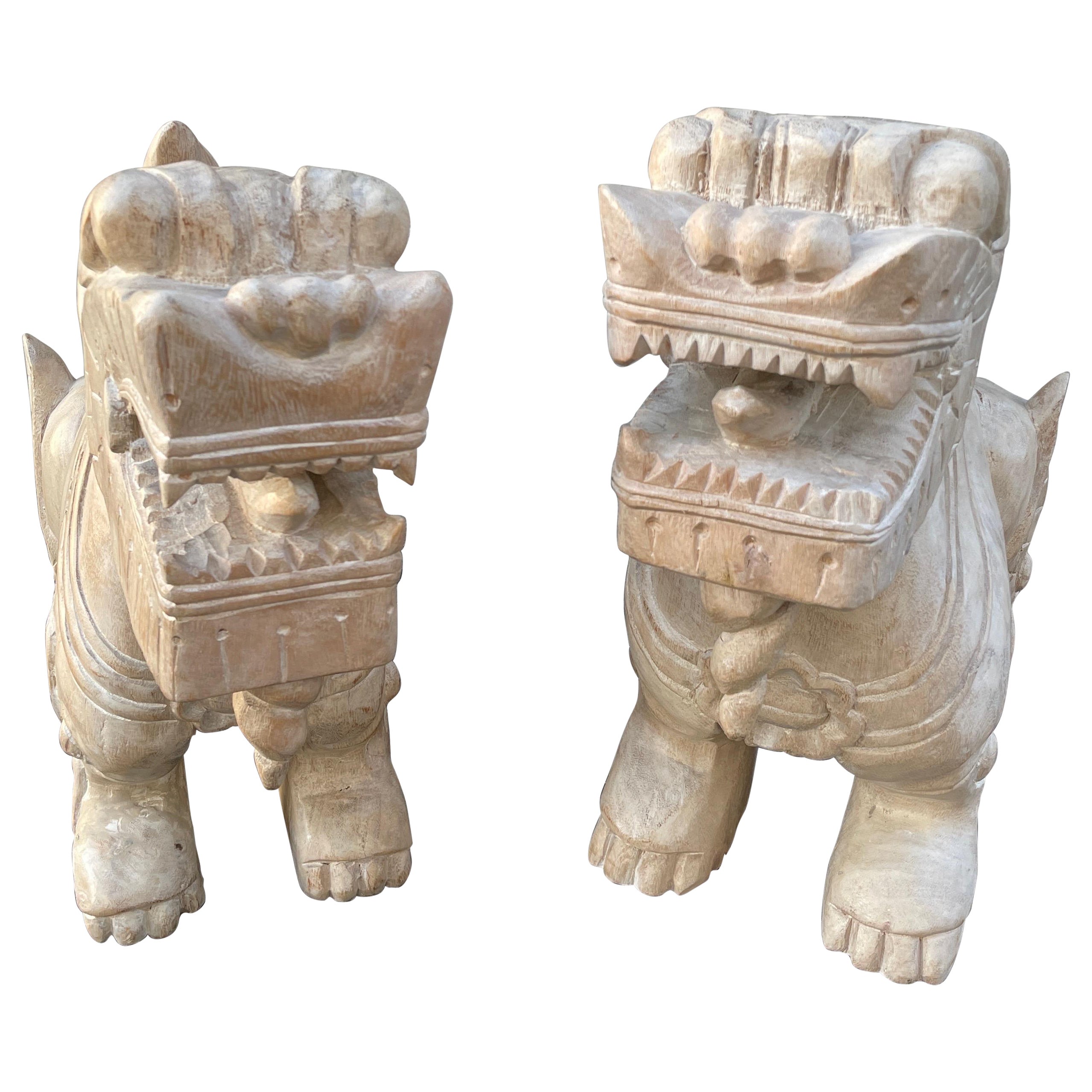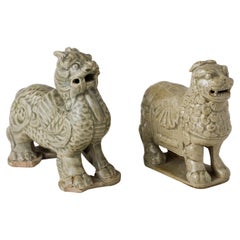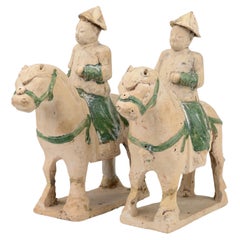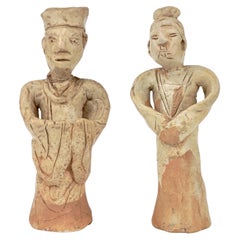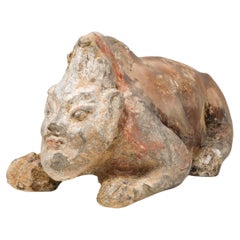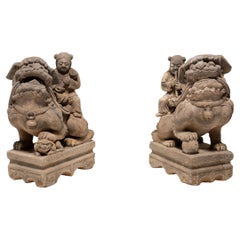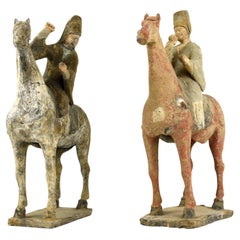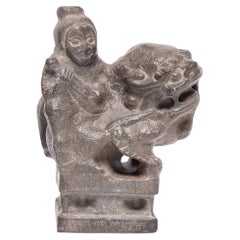Items Similar to Pair of Rider Figures on Mythical Beasts Possibly from Qing Dynasty
Want more images or videos?
Request additional images or videos from the seller
1 of 12
Pair of Rider Figures on Mythical Beasts Possibly from Qing Dynasty
$3,500per set
£2,643.06per set
€3,026.06per set
CA$4,942.91per set
A$5,396.48per set
CHF 2,829.15per set
MX$65,542.33per set
NOK 35,331.52per set
SEK 33,362.38per set
DKK 22,586.32per set
About the Item
Identical piece is housed in the Longhai Museum of Zhangzhou City. On October 7, 1989, it was appraised as a third-class cultural relic by the Cultural Relics Appraisal Team of the Fujian Provincial Cultural Relics Administration. The work is believed to date from the Qing Dynasty (1644–1911). It depicts a lion with its mouth open, baring its teeth. The figure is mounted on the lion’s neck, wearing a head ornament, while the lion itself is shown in a fierce posture.
Period: Possibly Qing Dynasty or Earlier
Medium : Earthenware or pottery
Size : 27cm (Height) x 24cm(Diameter)
Condition : Good
Provenance : Acquired in late 1990s from Hongkong
Reference : Longhai Municipal Museum
(Type : Highly related)
- Dimensions:Height: 10.63 in (27 cm)Diameter: 9.45 in (24 cm)
- Sold As:Set of 2
- Style:Qing (Of the Period)
- Materials and Techniques:
- Place of Origin:
- Period:
- Date of Manufacture:Possibly Qing Dynasty or Earlier
- Condition:Minor fading.
- Seller Location:seoul, KR
- Reference Number:1stDibs: LU9577244885312
About the Seller
4.8
Gold Seller
Premium sellers maintaining a 4.3+ rating and 24-hour response times
Established in 1999
1stDibs seller since 2023
44 sales on 1stDibs
Typical response time: 4 hours
- ShippingRetrieving quote...Shipping from: seoul, Korea South
- Return Policy
Authenticity Guarantee
In the unlikely event there’s an issue with an item’s authenticity, contact us within 1 year for a full refund. DetailsMoney-Back Guarantee
If your item is not as described, is damaged in transit, or does not arrive, contact us within 7 days for a full refund. Details24-Hour Cancellation
You have a 24-hour grace period in which to reconsider your purchase, with no questions asked.Vetted Professional Sellers
Our world-class sellers must adhere to strict standards for service and quality, maintaining the integrity of our listings.Price-Match Guarantee
If you find that a seller listed the same item for a lower price elsewhere, we’ll match it.Trusted Global Delivery
Our best-in-class carrier network provides specialized shipping options worldwide, including custom delivery.More From This Seller
View AllRare Yue Celadon-Glazed Two Haitai Statues, Western Jin dynasty (265-420)
Located in seoul, KR
The statue seems to be a mythical beast standing in a poised and alert stance, with its mouth open as if roaring or breathing fire. Its body is covered in detailed carvings that resemble scales and feathers, indicative of the high level of craftsmanship during the Jin Dynasty. The creature’s presence is both regal and intimidating, suggesting it might have been believed to possess protective properties.
Period : Western Jin Dynasty (266 - 316 AD)
Type : Haitai Statue
Medium : Yue celadon...
Category
Antique 15th Century and Earlier Hong Kong Chinese Export Antiquities
Materials
Celadon
Ming Dynasty Two Green Glazed Horses and Riders (15-16th Century)
Located in seoul, KR
Statues of Chinese horse riders, featuring glazes in green, are set on rectangular bases.
Period: Ming Dynasty
Medium: Green-glazed Pottery
Typ...
Category
Antique 15th Century and Earlier Hong Kong Ming Antiquities
Materials
Pottery
Two Incised Sandstone Mingqi
Located in seoul, KR
Figures from this era tend to be simpler and more utilitarian, reflecting the instability and regional diversity of the time. These pottery figures often unglazed or painted with bas...
Category
Antique 15th Century and Earlier Hong Kong Antiquities
Materials
Sandstone
Guardian(Half human half beast) Pottery Figure, Northern Wei-Tang Dynasty
Located in seoul, KR
This guardian figure represents a fusion of human and beast, a common motif symbolizing protection in Chinese lore. Crafted from pottery, the figure is a testament to the era's sculp...
Category
Antique 15th Century and Earlier Hong Kong Han Antiquities
Materials
Pottery
Guardian Official Pottery Figure
Located in seoul, KR
This figure appears to be a terracotta statuette, possibly representing a court official or a deity given the distinct headgear which could signify a rank or divine attribute. The style of the figurine, with its facial features and remnants of paint, suggests it could be a part of funerary art, which was common in Chinese culture during these periods.
Date : Northern Wei...
Category
Antique 15th Century and Earlier Hong Kong Tang Antiquities
Materials
Earthenware, Pottery
Two Figures of Attendants, Ming Period(1368-1644)
Located in seoul, KR
Statues of attendants crafted from terracotta, featuring glazes in green, Set on rectangular bases.
Period: Ming Dynasty
Medium: Glazed Pottery
Type: Figure
Condition : Excellent(It has soil on it, which is presumed to be evidence of excavation)
Provenance : Acquired in late 1990s from Hongkong
Reference :
1) Indianapolis Museum of Art - Dinastia ming, figure maschili, 1368-1644
(Type : Closely related)
2) V&A Museum - Accession number FE.295:1, 2-2005
(Type : Closely related)
3) Sotheby's 01 May 2007 - The Collection Of Paul Otto Taubert & Jewellery And Decorative Arts - Lot 233
(Price range : 5,000 - 7,000 AUD / Type : Closely related)
4) Asian Art Museum, San Francisco - Object number B60P1631 - Standing Man Tomb Figure
* Ming Dynasty Glazed Pottery Figures
Ming Dynasty glazed pottery figures are renowned for their bold color palette, intricate detailing, and lifelike forms, distinguishing them from earlier traditions. These figures, which depict officials, warriors, animals, and mythical creatures, are characterized by high-gloss lead-based glazes in green, amber, ochre, and sancai (three-color) combinations. The thickly applied glaze pools in recesses, creating depth and enhancing sculptural details. With dynamic postures, expressive facial features, and meticulously rendered drapery, these figures reflect the period’s advancement in ceramic craftsmanship, offering a greater sense of movement and realism compared to the rigid and stylized forms of earlier dynasties.
A defining characteristic of Ming glazed pottery is its elaborate surface detailing, often achieved through raised relief elements and contrasting glazes. Equestrian figures, for example, feature carefully sculpted saddles, harnesses, and decorative embellishments, while human figures are adorned with intricate robes and headdresses. The large scale of these tomb figures, often more imposing than those from previous periods, underscores the increasing importance of funerary art during the Ming era. Unlike later Qing Dynasty figures...
Category
Antique 15th Century and Earlier Hong Kong Ming Antiquities
Materials
Pottery
You May Also Like
Pair of Chinese Guardian Fu Lions with Riders, c. 1850
Located in Chicago, IL
This pair of intricately carved limestone fu lions once protected the entry of a grand courtyard home in 19th-century China. Also known as shizi or foo dogs, the mythical creatures a...
Category
Antique Mid-19th Century Chinese Qing Sculptures and Carvings
Materials
Limestone
Pair of Tang Equestrians
Located in Santa Monica, CA
Tang Equestrians 14.5h
Each is an unglazed grey pottery horse with a musician rider. The horse is depicted standing on four legs on a base with a rider playing a musical instrument....
Category
Antique 15th Century and Earlier Chinese Tang Sculptures and Carvings
Materials
Terracotta
$6,500 / set
China 618-907 AD Tang Dynasty Pair Of Polychromate Earth Spirits Zhenmushou
Located in Miami, FL
Pair of Earths Spirits "Zhenmushou" from the China Tang Dynasty 618-907 AD.
A beautiful and rare pair of "Earths Spirits guardians" from the Yunnan province region in the ancient China. This was created in clay earthenware pottery during the Tang Dynasty period between 618 and 907 AD. Featuring the molded figures of two seated guardians with decorations with polychrome pigmentations. The figures are seated on their haunches with cloven hooves planted firmly on the base looking forward with their front legs in a straight position. Both with face and body alert expressions on a rectangular base.
Earth spirits usually appear in pairs, one with a human head and the other with a lion head. Their supernatural powers, indicated by antlers, spiky flanges and flames, enable them to confront evil spirits and protect any precincts within their gaze. Have been believed to protect the living by keeping the spirits of the dead from inappropriately roaming the world outside the tomb.
Zhenmushou or guardian deities, developed from a line of protective spirits found normally in pairs at the front of Tang dynasty tombs. They served both to protect the figure from untoward spirits, and the outside world from the roving spirit of the dead. Combining features from a number of animals to form the perfect mythic beast, these mythical creatures were perceived to be the ideal guardians of the dead
The semi human faced figure has a measures of 11.25 by 4.5 by 5.75 inches (28.57 x 11.43 x 14.60 Cm).
The mythological lion animal figure has a measures of 10 by 5 by 5.8 inches (24.5 x 12.7 x 14.73 Cm).
Tang dynasty or Tang Empire, was an imperial dynasty of China that ruled from 618 to 907, with an interregnum between 690 and 705. It was preceded by the Sui dynasty and followed by the Five Dynasties and Tend Kingdoms period. Historians generally regard the Tang as a high point in Chinese civilization, and a the golden age of cosmopolitan culture. Tang territory, acquired through the military campaigns of its early rulers, rivaled that of the Han dynasty.
The Li family founded the dynasty, seizing power during the decline and collapse of the Sui Empire and inaugurating a period of progress and stability in the first half of the dynasty's rule. The dynasty was formally interrupted during 690–705 when Empress Wu Zetian seized the throne, proclaiming the Wu Zhou dynasty...
Category
Antique 15th Century and Earlier Chinese Tang Antiquities
Materials
Earthenware, Pottery
$4,312 Sale Price / set
25% Off
Petite Chinese Fu Dog Guardian with Rider
Located in Chicago, IL
With a curly mane and playful expression, this petite stone fu dog is an adorable companion and a benevolent guardian of the home. Also known as a lion or shizi, the mythical dog is ...
Category
21st Century and Contemporary Chinese Chinese Export Sculptures and Carv...
Materials
Limestone
Pair of Chinese Stone Fu Lion Guardians, c. 1800
Located in Chicago, IL
This pair of limestone fu lion-dogs once protected a grand courtyard home in 19th-century China. Skillfully carved in attentive postures, the mythical lions are known as “shizi,” pow...
Category
Antique Early 19th Century Chinese Qing Sculptures and Carvings
Materials
Limestone
$13,880 / set
Pair of Large Carved Wood Foo Dogs
Located in West Palm Beach, FL
Pair of large & impressive carved Chinese foo dogs.
Category
20th Century Chinese Sculptures and Carvings
Materials
Wood
$1,450 / set
More Ways To Browse
Qing Dynasty Furniture
Antique Beast
Relic Antique
Bactrian Idol
Chinese Brass Pots
Japanese Doll Edo Period
Japanese Hair Ornaments
Khmer Jar
15th Century Oil Lamps
Ancient Chinese Artifacts
Antique Chinese Opium Scale
Antique Fans India
Chinese Coconut Cup
Chinese Duck Pair
Chinese Man Pottery
Chinese Terracotta Soldier
Geisha Pillow
Han Dynasty Chinese Cocoon Jar


